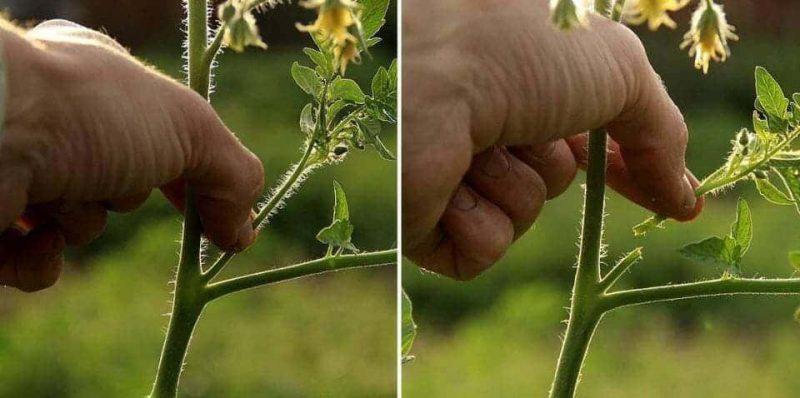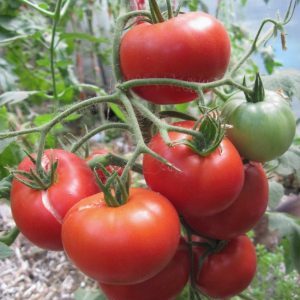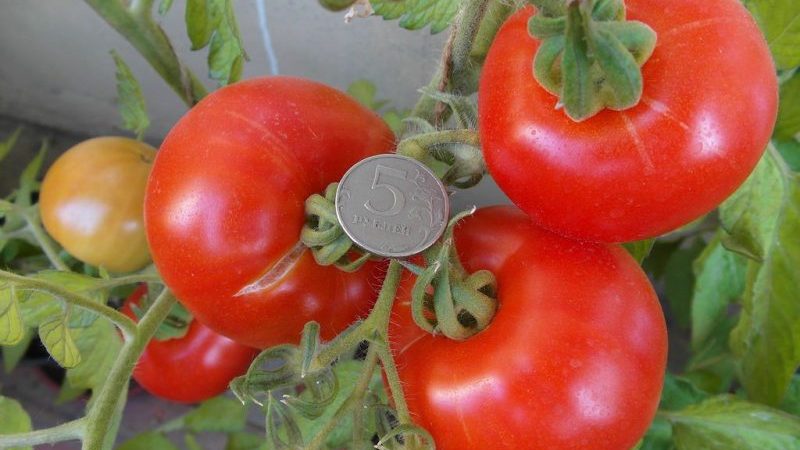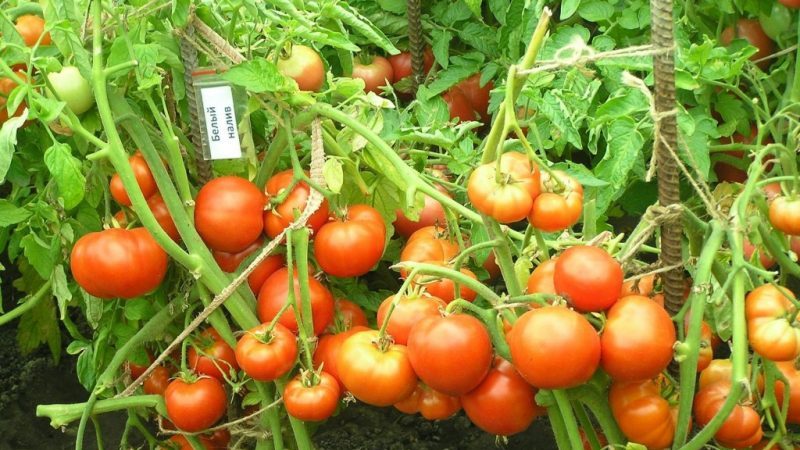We form bushes correctly: do undersized tomatoes stepchild and which varieties do not require this stage
Despite the abundance of tomatoes in stores and markets, many people continue to grow tomatoes on their own. And this is understandable - your products from the garden are both tastier and healthier.
Some gardeners prefer open ground, others prefer greenhouses, and still others prefer home windowsills. And if there are special undersized varieties for growing tomatoes in an apartment, then on your site the choice of seed material for cultivating low tomatoes is not so obvious. In addition, not all gardeners are aware of whether it is necessary to remove stepchildren from stunted bushes.
From the article you will learn whether it is necessary to pinch low-growing varieties for greenhouses and open ground, and how to do it correctly.
The content of the article
What is pinning
Stepsons are lateral shoots on the stem that grow between the tomato stem and the leaf, in the axils. Grazing is the removal of these processes.

There are two ways to perform the procedure:
- With hands in rubber gloves... The stepson is swung from one side to the other until it comes off. This is done in the morning - at this time, the stems are more juicy, and there is also time to close the wound.
- With a sharp knife or scissors. Cut with precise movements, when moving to another process, treat the instrument with a disinfectant solution (1% bleach, 1% potassium permanganate or a weak solution of potassium permanganate). To prevent the growth of new stepchildren, a 1.5 cm process is left in this place. The cut stems are removed from the greenhouse to avoid infection.
Remove stepchildren before they reach 5 cm, otherwise it will injure the tomato and reduce yields.
There is no practical benefit from stepchildren. By removing them, you send beneficial trace elements to flowers and fruits. If this is not done, the plant will begin to "fatten", the quality and quantity of the crop will decrease.
There are 2 types of pinching of low-growing tomatoes:
- Stealing in two stems. They leave one of the strongest stepson, the rest are removed.
- Three-stem grazing. One stem and two stepsons are left. The strongest process is selected from the lower inflorescences and another one next to it.
It is necessary to distinguish the stepson from the stem:
- leaves grow on the stepson, flower ovaries immediately appear on the stem;
- the stepson grows from the sinuses, the new stem from the main one.
Grasshopping is carried out throughout the life of the plant.
Features of growing undersized tomatoes
Low-growing tomatoes, or determinant ones, are loved for their early maturity, they give few stepsons, they ripen together. The pickling of low-growing tomatoes takes place in 2 or 3 stems. This improves the quality and quantity of the fruit. The less nutrients are spent on the leaves, the more will go to the fruit.
With a large number of stepchildren and leaves, it is difficult to harvest without damaging the plants. It turns out real thickets, through which you have to wade.
Also, do not forget about tying tomatoes. With good care, the fruits are quite weighty and can break off the branch. This will lead to injury to the plant and, as a result, impairment of fruiting.
The exception is standard tomato with a height of 40-60 cm and a thick stem. Such plants are grown even on the windowsill.
There are many varieties of low-growing tomatoes that do not require pinching. Such plants have excellent resistance to low temperatures. If you grow them without seedlings, i.e.plant directly into open ground, they will be hardened, stress-resistant.
Low-growing tomatoes are suitable for novice vegetable growers or people who, due to their workload, cannot devote much time to the formation of plants.
reference... Undersized non-singing tomatoes are practically not affected late blight... This disease most often affects plants at the end of August. By that time, undersized tomatoes almost stop bearing fruit.
Open field tomatoes that do not require pinching
Consider some of the features of planting tomatoes in open ground:
- cover the seedlings in the first days after planting to prevent leaf burns;
- choose a site that is as protected from the wind as possible;
- plant seedlings no later than the end of April, seeds - mid-May;
- keep the seeds in wet gauze for about 4 hours before planting;
- choose tomato varieties suitable for your climate.
Many vegetable growers ask themselves the question: is it necessary and how to pinch low-growing tomatoes?Now there are many varieties of tomatoes for open ground that do not need pinching:
- Agatha... It ripens well in open ground and greenhouses. Productivity - 2 kg per bush.
- Adelina... Height - about 40 cm, mid-season, cylindrical fruits, yield - 3 kg per bush.
- Watercolor... Height - 50 cm, mid-season, elongated fruits, yield - 7 kg per 1 m².
- Alaska... Height - 50 cm, early ripening, yield - 2 kg per bush.
- White filling... Height - 50 cm, early ripening, yield - 2 kg per bush.
- Gnome... Height - 40 cm, early ripening, small fruits, yield about 5 kg per 1 m².
- Explosion... Height - 60 cm, early ripening, yield - 3 kg per bush.
- Currency... Height - up to 80 cm, mid-season, yield - up to 6 kg per 1 m².
- Lady fingers... Height - about 60 cm, early ripening, fruits are small, elongated, yield is about 10 kg per 1 m².
- Rocket... Height - 60 cm, mid-season, yield - up to 6 kg per 1 m², elongated fruits.
- Raspberry Viscount... Height - 55 cm, early maturing, yield - up to 6 kg per bush.
- Golden stream... Height - 70 cm, early maturing, yield - up to 10 kg per 1 m².
Many varieties have been created for the greenhouse:
- Alsou... Height - up to 1 m, early maturing, yield - 8 kg per 1 m².
- Danko... Height - up to 1.5 m, mid-season, yield - 3 kg per bush.
- Honey cream... Height - up to 1.2 m, early ripening, yield - up to 10 kg per 1 m².
- Nevsky... Height - 50 cm, early ripening, yield - 8 kg per 1 m².
- Sanka... Height - 60 cm, early ripening, yield - up to 2.5 kg per bush.
- Betalux... Height - 50 cm, early ripening, yield up to 4 kg from 1 m².
- Magus H... Height - 60 cm, early ripening, yield - 3 kg per bush.
- Orange princess... Height - up to 100 cm, medium late ripeness, yield - up to 40 kg per bush. Fruit color is bright orange.
- Aztec... Height - up to 40 cm, early maturing, yield - up to 5 kg per 1 m².
- Amber... Height - up to 60 cm, early maturing, yield - up to 6 kg per 1 m².
- Pink angel... Height - up to 60 cm, early maturing, yield - up to 5 kg per bush.
All varieties of low-growing tomatoes, large-fruited or cherry tomatoes, even without pinching, need minimal care: watering, feeding and tying up.
Formation of tomatoes without pinching

To get a rich and high-quality harvest, you need to know how to form tomatoes correctly. This concept includes pruning leaves and stepchildren. There is no need to pinch the brushes of undersized tomatoes, since they themselves stop growing, while all minerals go to the ripening of the crop.
Trim the leaves before flowering. They begin within 10 days after disembarking the seedlings. Leaves are removed gradually - the plant is under stress. Best of all, 2-3 sheets, no more than 2 times a week. Pull in an upward motion, otherwise the skin may catch on the trunk and cause additional stress on the plant.
The lower leaves are subject to complete removal: this improves air exchange.It is recommended to cut them off under each tied brush, as soon as small green tomatoes appear on the branch.
By the end of summer, when the tomatoes cease to bear fruit, remove all the leaves so that the forces go to ripen the fruits.
Removing leaves also prevents diseases, insect pests that feed on leaves from developing in tomatoes. Like pinching, leaf pruning is best done in the morning.
Each climate has its own nuances of growing undersized tomatoes. For example, in the southern regions of Russia, where there is a lot of sun, the leaves of tomatoes growing outdoors are removed as needed. Remember that they protect the fruit from sunburn. Conversely, in the north, where there is little sun, it is better to remove the leaves immediately, since they create shadow.
Important! Remove blackened, yellow, and mottled leaves. They can be affected by disease or pests. In hot weather, cover the planting with a layer of white spandbond to protect the plant from burns.
Care of stunted tomatoes

Watering tomatoes often is not worth it. In dry weather, this is done 2-3 times a week. In cloudy - 1 time. Of course, the condition of the soil and the plant is worth looking at. Moisture retention promotes mulching. If the mulch lies in a dense layer, then weeding is often unnecessary.
Tomatoes are fed with 2 liters of ash, filled with 5 liters of boiling water. When the solution cools down, add water to 10 liters, add 10 g of boric acid and 10 ml of iodine. We insist for a day. After that, we dilute it 10 times more. We water the plant with such feeding after the formation of ovaries. One bush - 1 liter.
Tips & Tricks

To ensure the best tomato care, carefully read the recommendations written on the seed packaging. Buy products from bona fide and trusted manufacturers.
Water the tomatoes at the root - do not pour water on the leaves. In hot weather, they will get burned, in cloudy weather, the risk of late blight will increase.
It is best to make a small indentation near the trunk or organize drip irrigation: this will not damage the roots. Organize regular ventilation in greenhouses. Thanks to this, the plants will be pollinated, and the risk of contracting late blight will decrease.
Use only warm water. Otherwise, the plants will get sick.
Conclusion
For inexperienced gardeners or those who do not want to waste a lot of time caring for plants, undersized varieties are best suited. They do not require much trouble and forgive beginners for many mistakes. The main thing is to follow the recommendations: to carry out pinching of tomatoes, pruning of leaves, regular watering, feeding and airing of greenhouses. With proper care, you can enjoy your harvest in mid-summer.